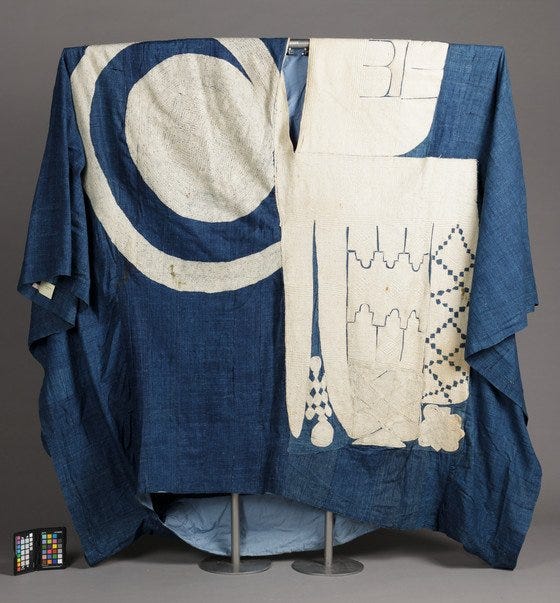More than a costume.
Broadening the history of African dress and adornment and designing new marketplaces for systemic change.
Hello everyone,
This week we are bringing you various perspectives on African dress and adornment and featuring the first talk from our new conversation series! If you appreciate our work and want to help us continue on into the new year, consider setting up a sustaining, “monthly gift” (of any amount) over at our donation page. With enough donations, we are able to see new endeavours through in 2021, such as providing a weekly news journalist and additional researchers from marginalized communities. Thank you for being a subscriber!
Objects That Matter: The West African Boubou
'Objects That Matter' features numerous fashion objects, images and collections that have been under-researched or left out of fashion history books and museums. We explain why they matter, as many of these items have been widely appropriated or referenced. Researcher and guest contributor Tayana Fincher introduces us to the West African Boubou:
A boubou is an over-the-head, draped garment with wide sleeves, historically worn by men. The cloth was strip woven and cut for the neck opening, dyed by professionals, and heavily embroidered by religious scholars and artisans as a sign of prestige.
Boubous are now industrially printed in manufacturing facilities, allowing for more accessibility and affordability. Juxtaposed against older, handmade examples, contemporary versions mimic the flowing quality but are much lighter and thinner.
Similar textiles with different colors, motifs, and materials are now produced and worn throughout all of West Africa, but also around the world where specific knowledge about symbols are not known or misunderstood.
Photo: West Africa, Nigeria, Hausa or Nupe, Man’s Tunic (Agbada), mid-20th century, silk and cotton plain weave with cotton embroidery, length 152.4 cm., Los Angeles County Museum of Art, Costume Council Fund (M.75.9). (Photo: Los Angeles County Museum of Art).
We invite you to read Tayana’s entry to learn more about the boubou’s widespread influence and appropriation in mainstream fashion retail.
From the Library: A Spotlight on African Fashion
For this week’s roundup of sources from The Library, Research Assistant Kai Marcel surveys some of the sources we have gathered when it comes to dress on the continent of Africa. Here’s what inspired Kai:
This week’s roundup centers fashion on the African continent. The canon of fashion history is one that often excludes non-white cultural producers who exist outside of Europe and the United States. In the past, when African fashion has been included, at best, it was presented as simple and unchanging—and as “costume” instead of “fashion.” At worst, it was not presented at all. Here is a selection of five different sources that can help us to decolonize and broaden the scope of the global fashion system.
Africa Rising: Fashion, Design and Lifestyle from Africa by Clara Le Fort & Robert Klanten (Book)
Good as Gold: Fashioning Senegalese Women by Kevin D. Dumouchelle (Exhibition)
Afrosartorialism by Dr. Enrica Picarelli (Website)
Conflict and Costume: The Herero Tribe of Namibia by Jim Naughten (Book)
‘The Fashion Culture in South Africa’ by Ickyof (Documentary)
Image Credit: ‘Kenyan Tribal Dance,’ John McArthur. 2018.
The topic of African Fashion is addressed from various angles, and we are always looking to diversify our range of authors and sources. We invite your suggestions via our 'Contact Us' page!⠀
The Fashion and Race Database Conversation Series: ‘Retail as a Portal’
In case you missed it last month, we launched The Fashion and Race Database Conversation Series, kicking things off with a three-part panel series entitled, ‘Retail as a Portal.’ The idea was to explore how retail can empower us to produce and consume with positive, social impact and ignite systemic change. I hosted the series and was joined by figures in our fashion constellation who are leading through visionary thinking and doing.
The first instalment of this series, ‘Retail as a Portal: Designing New Marketplaces for Systemic Change,’ featured an acclaimed design duo and an ethnobotanist who are transforming retail in both concept and practice.
Directory Spotlight: Costume Institute of the African Diaspora
This week, our Media Editor Daniela Hernandez encourages you to check out The Costume Institute of the African Diaspora:
The Costume Institute of the African Diaspora (CIAD) is dedicated to researching the history and culture of clothing and adornment from the African Diaspora — and using that research to produce outcomes such as projects and lectures in order to educate the public about dress cultures developed by people of African heritage.
That’s it for this week. Stay safe and take good care.
Yours in service and solidarity,
Kim Jenkins
Founder, The Fashion and Race Database





